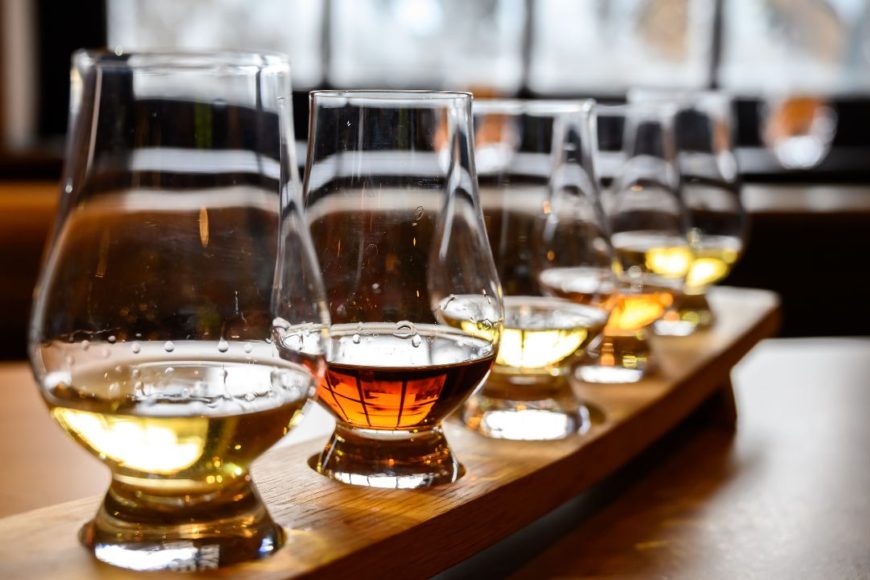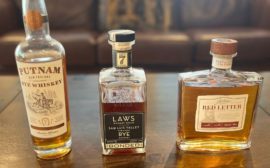The Whisky Knights Tasting Experience started in 2013 as The Whisky Knights Tasting Club. The club allowed me to connect with friends, meet new people, and learn about new whiskies and whiskey categories. Today, we meet once a quarter and have approximately 30 members.
The following are a few ideas to consider when starting a whiskey club or joining one:
Determine the Goal of the Whiskey Club
Some clubs can have a specific objective, like learning about Scotch Whisky or educating women in the art of tasting and appreciating whiskey.
For The Whisky Knights, I kept things open by focusing on the main styles of whiskey, including Scotch, Bourbon, Irish, Japanese and Canadian. The flexibility allowed me to gear toward different flavor profiles depending on the audience while providing an engaging and educational experience based on the whiskey category selected that night. This topic provides a great segway to my next component of a tasting.
Education on Whiskey
Most tastings I have attended tend to focus on flavors and information about the distillery and perhaps one or two anecdotes, but what about going deeper into blending, sharing a private tasting when visiting a distillery, etc.?
Story-telling, product information, and first-hand experiences will set the club apart from many others. I have had disappointing tasting experiences and learned what NOT to do.
A plus to a tasting experience is to bring a guest speaker to make it very engaging. The guest could be a brand ambassador, a distiller, or anyone in the industry with expert knowledge.
Know your Audience
Know the audience (i.e., beginner, intermediate, advanced) before the tasting and tailor the content based on the audience’s profile. If the audience has varying levels of knowledge, introduce basic concepts and some advanced ones to keep things interesting.
The Theme of the Whiskey Tasting
Before the tasting, you may brainstorm some ideas with your audience (friends) on what the theme of the tasting should be. Here are some popular themes:
- Vertical Tasting: Exploring different age statements from the same distillery. (i.e., 10-years-old, 12-years-old, etc.) Here you will learn about the distillery’s character and the barrel’s influence on the new make spirit.
- Whiskies of the World. One expression from each of the main whiskey-producing countries mentioned above. The tasting is arranged from lower to higher proof whiskies, with the most delicate styles (i.e., Hibiki Harmony Japanese Blend) placed at the beginning to more robust and intense whiskies at the end.
- Whiskey Regions. This theme focuses on whiskies from a whiskey-producing region, province, or state and finding similarities and differences in flavor profiles. Examples may include Speyside, Tennessee, Alberta, and Kentucky.
- Blind Tasting Competition. These are one of the most fun tastings I facilitate. As with any other blind tasting, you will be served up to six expressions and get points for knowing the correct answers. One point for the country of origin (i.e, Ireland), two points for the type of whiskey (i.e., Single Malt, Irish Pot Still Whiskey, Scotch Blend, etc.), and three points for the distillery or brand (i.e., The Macallan). Results are updated on TV for everyone to see after each whiskey. The winner and runner-up get prizes. Participants LOVE this type of tasting.
The Number of Whiskies
I recommend no less than three and no more than six whiskies. The reason is that less than three whiskies will leave the audience wanting more because the taste buds are just getting warmed up. Having more than six whiskies and you will experience palate fatigue. At some point, all whiskies will start tasting the same.
Also, participants might want to leave a few drops of the first whiskey and try it again after the last whiskey of the flight. Remember that in the first whiskey, the taste buds were still getting used to the alcohol, causing some participants to miss the flavor profile.
The Whiskey Selection
One of the most important topics of any whiskey tasting. What to offer? Should the Whisky flight include easy to find whiskies? Rare whiskies? Or both?
The answer depends on the audience’s flexibility and their degree of knowledge. A rare whiskey can be a treat after the tasting. Good whiskies that go under the radar are great options for the tasting. These are the hidden gems.
Proper Glassware
Selecting the right glasses for your tasting is very important. Your tasting glass should have a narrow top to allow aromas to concentrate while nosing the whiskey. You may use any of these glasses, but my favorite is the Glencairn glass.
Glencairn: https://www.glencairnwhiskyglass.com/
Copita Image: Copita Glass
Taster Image: Taster Glass
A Nice Tasting Sheet
A tasting experience is not just listening to what others say but also writing down what you liked and found interesting in whiskey. A flavor map is a plus since it helps to locate the style and character of the whiskey in each quadrant.
Flavor Map: https://www.scotchmaltwhisky.co.uk/whiskyflavourmap.htm
Water and Droppers
Staying hydrated is essential in a tasting experience. Water will also allow resetting your palate when transitioning from one whiskey to the next. A few drops of water will come in handy to change some of the flavors in a whiskey.
The Food
Another essential component of a whiskey tasting. I recommend eating a light meal before going to a whiskey tasting. Also, during the tasting, you may want to provide snacks that will pair well with the flight of whiskies. These could be cheeses, crackers, etc. However, avoid eating spicy foods during the tasting because it can throw off your palate and limit your ability to identify delicate flavors.
The Whisky Knights Tasting Club offers food at the end of each tasting.
Membership Fee
Some whiskey clubs have a one-time initiation fee, and others have a monthly fee or both. Determine the level of commitment you want from your members or how much you want to commit to a club before joining.
The Whisky Knights have a pay-per-tasting format. Alternatively, each member can bring a bottle to share and waive the tasting fee. My only ask with this format is for the owner to research the whiskey and share the information with others.
As a side note, guests become official members (Knights) after attending three tastings in a year. I created this rule to determine people’s commitment and evaluate the candidate’s contribution to the club.
Great People
Last but not least is the caliber of participants in the tasting. The tasting experience is about learning, relaxing, and having fun. Since most guests are friends of a Knight, the chances of bringing a whiskey snob to the group are slim.
One final comment. Anyone can open bottles and call it a tasting, but you and your members drive the tasting experience to make it memorable. I always follow these principles in my tastings: Keep it simple, keep it quality (not quantity), and keep it fun.
Participants might not remember everything said that day, but they will remember how the group made them feel. I hope you find this article helpful for your next tasting. Cheers!
Guillermo Barrios
Executive Bourbon Steward
Certified Bourbon Professional
Diploma in Single Malt Scotch
Certified Specialist of Spirits





